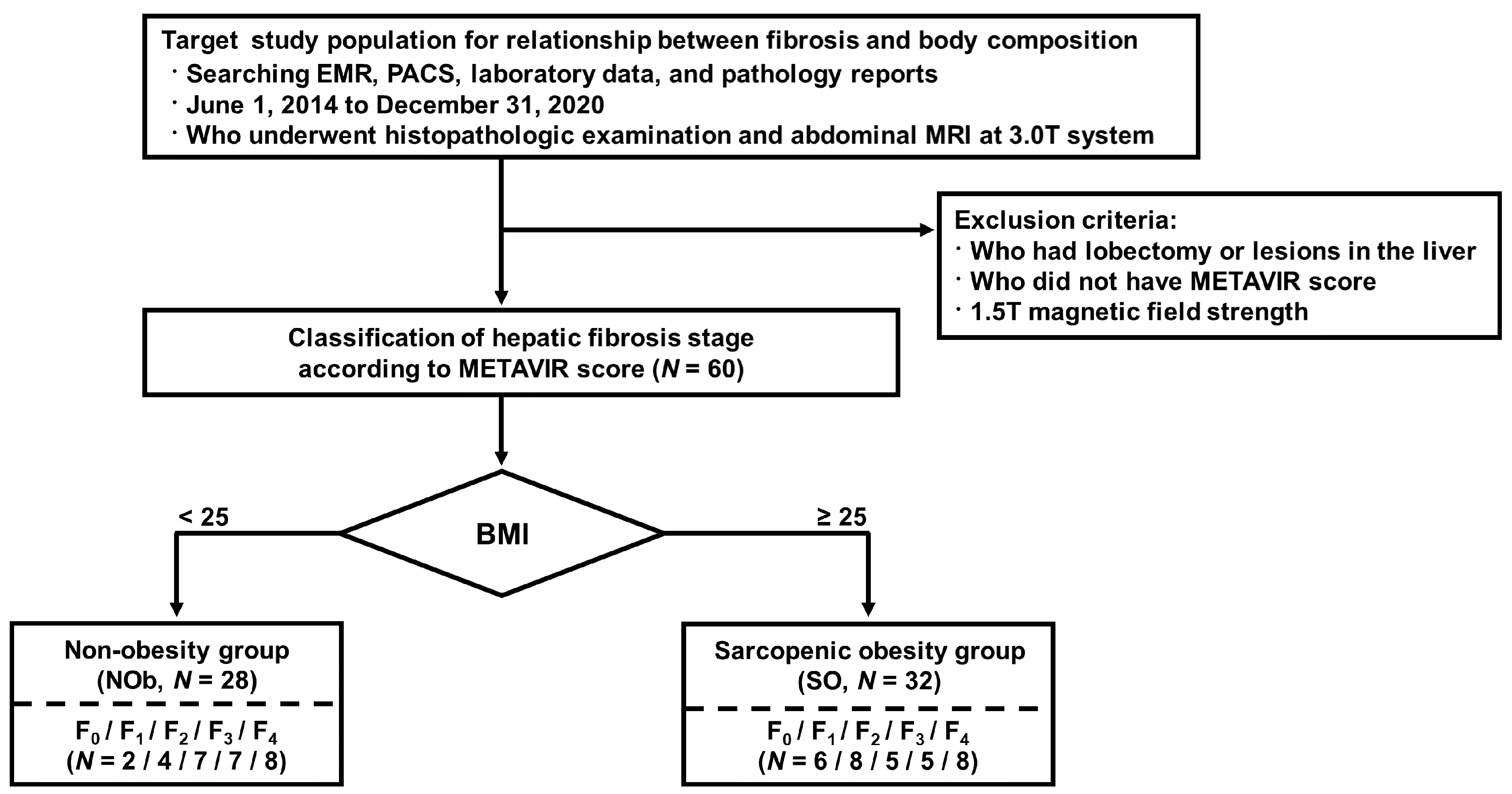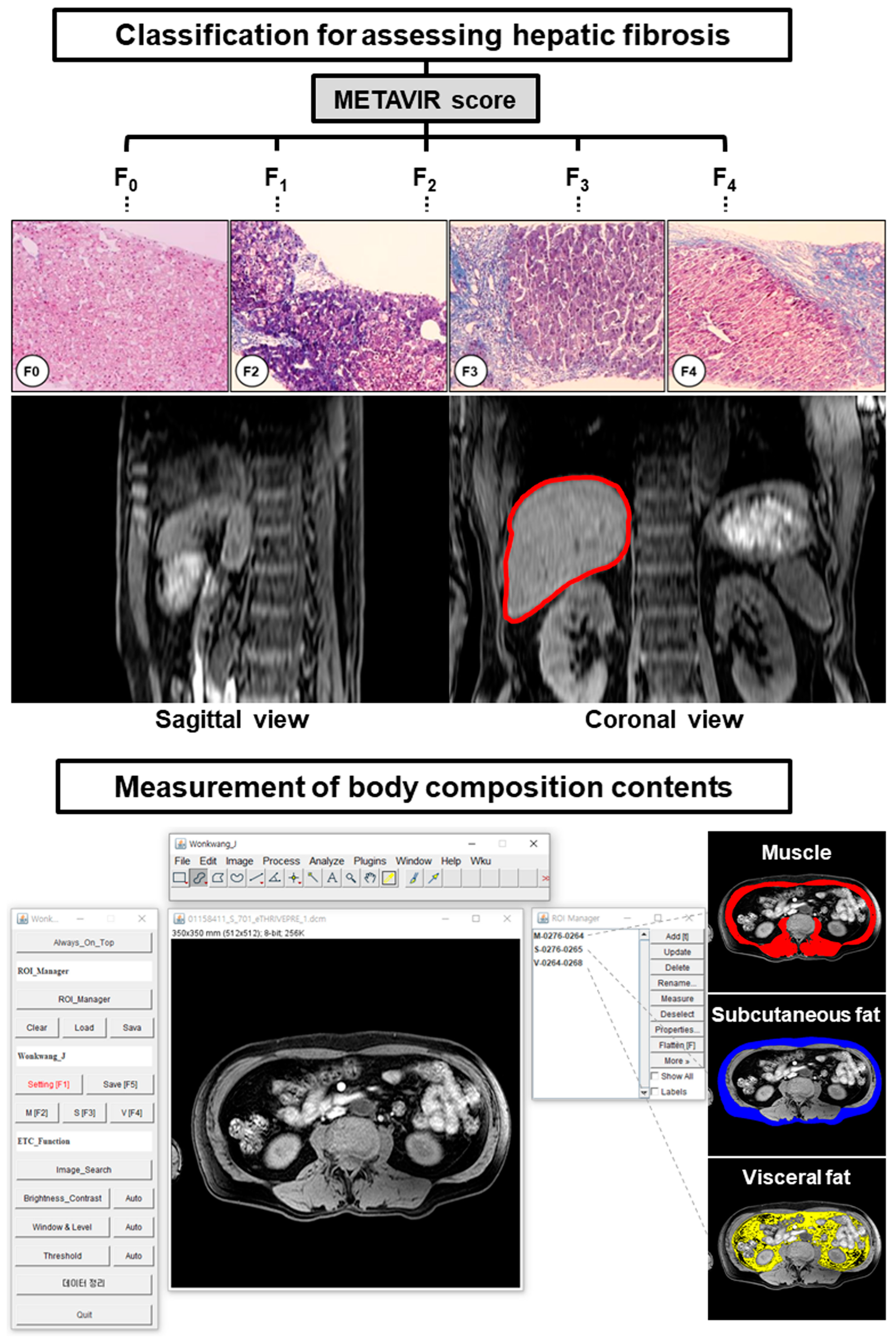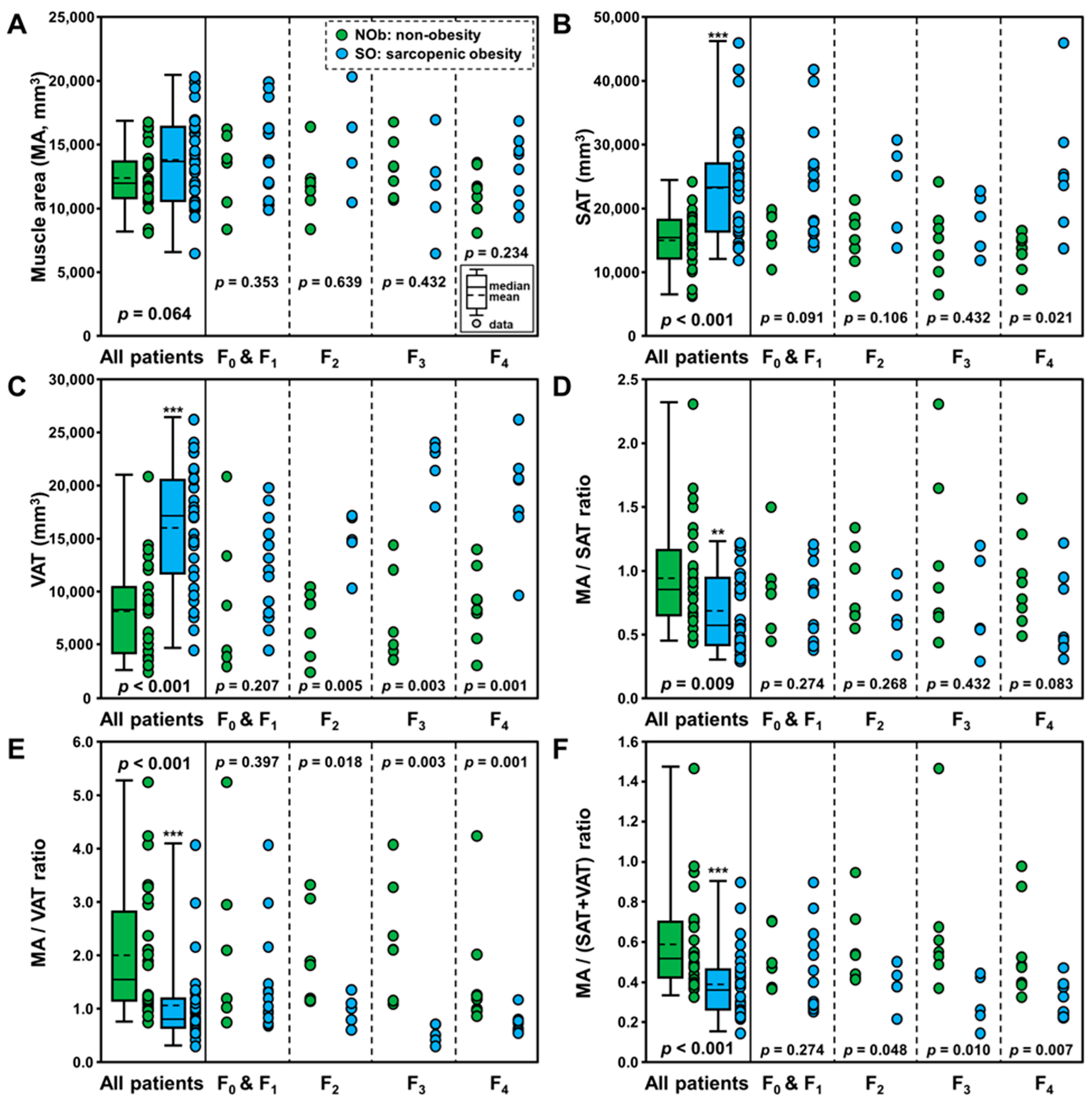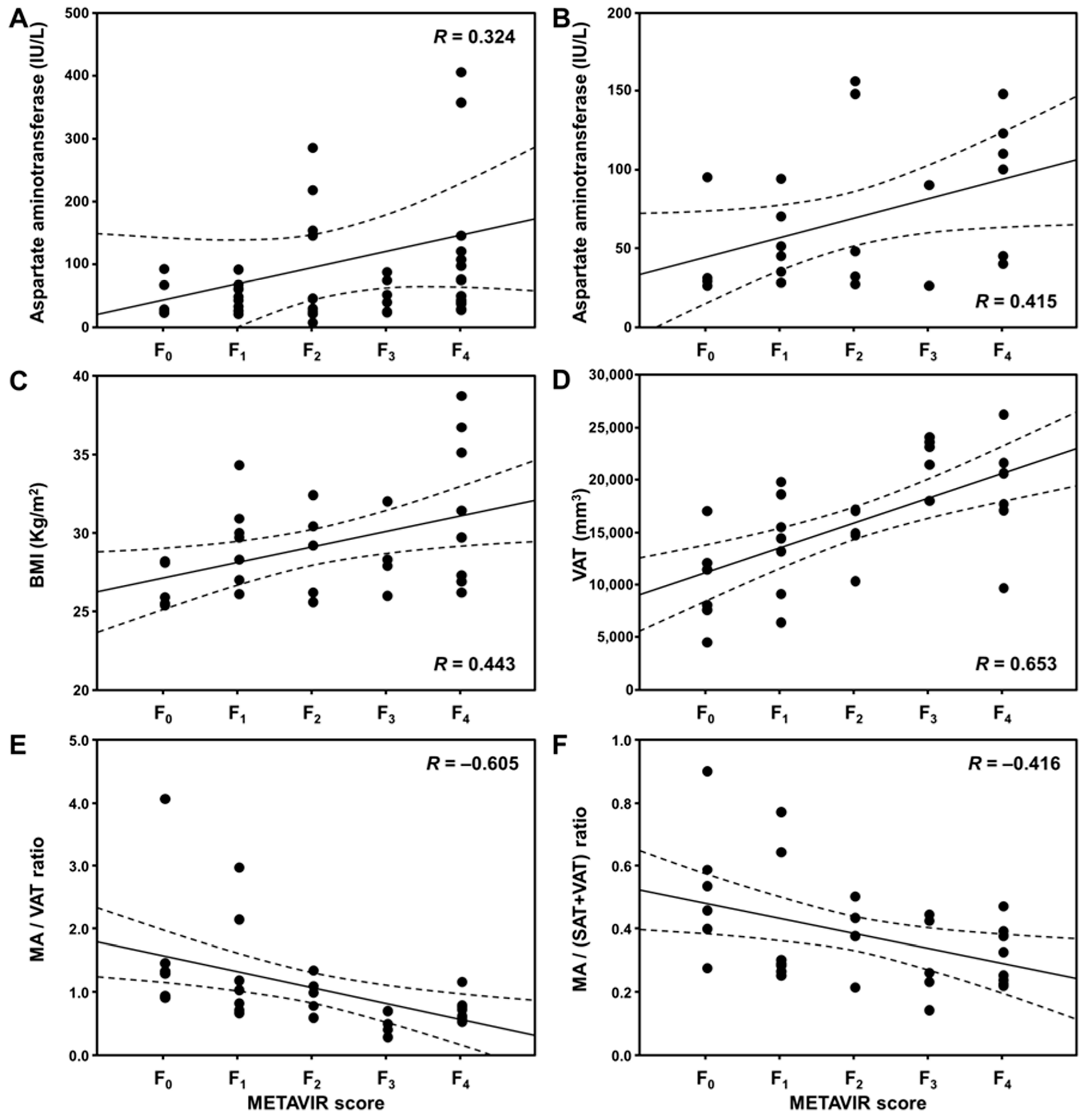Association between Body Composition Contents and Hepatic Fibrosis in Sarcopenic Obesity
Abstract
1. Introduction
2. Subjects and Methods
2.1. Ethics Statement
2.2. Patient Population
2.3. Reference Standard for Diagnosing Liver Fibrosis
2.4. Magnetic Resonance Imaging for Abdomen
2.5. Measurement of Body Compositions on Third Lumbar Vertebra MRI
2.6. Data Processing and Quantification of Magnetic Resonance Imaging Scans
2.7. Statistical Analysis
3. Results
3.1. Patient Characteristics
3.2. Patient Classification and Measurements of Body Composition Contents
3.3. Body Composition Contents in Sarcopenic Obesity with Liver Fibrosis
3.4. Correlation between Liver Fibrosis and Body Composition Contents in SO
4. Discussion
5. Conclusions
Author Contributions
Funding
Institutional Review Board Statement
Informed Consent Statement
Data Availability Statement
Conflicts of Interest
References
- Barazzoni, R.; Bischoff, S.C.; Boirie, Y.; Busetto, L.; Cederholm, T.; Dicker, D.; Toplak, H.; Van Gossum, A.; Yumuk, V.; Vettor, R. Sarcopenic obesity: Time to meet the challenge. Clin. Nutr. 2018, 37, 1787–1793. [Google Scholar] [CrossRef]
- Xie, W.-Q.; Xiao, G.-L.; Fan, Y.-B.; He, M.; Lv, S.; Li, Y.-S. Sarcopenic obesity: Research advances in pathogenesis and diagnostic criteria. Aging Clin. Exp. Res. 2021, 33, 247–252. [Google Scholar] [CrossRef] [PubMed]
- Nezameddin, R.; Itani, L.; Kreidieh, D.; El Masri, D.; Tannir, H.; El Ghoch, M. Understanding sarcopenic obesity in terms of definition and health consequences: A clinical review. Curr. Diabetes Rev. 2020, 16, 957–961. [Google Scholar] [CrossRef]
- Lee, K.; Shin, Y.; Huh, J.; Sung, Y.S.; Lee, I.S.; Yoon, K.H.; Kim, K.W. Recent issues on body composition imaging for sarcopenia evaluation. Korean J. Radiol. 2019, 20, 205–217. [Google Scholar] [CrossRef] [PubMed]
- Donini, L.M.; Busetto, L.; Bischoff, S.C.; Cederholm, T.; Ballesteros-Pomar, M.D.; Batsis, J.A.; Bauer, J.M.; Boirie, Y.; Cruz-Jentoft, A.J.; Dicker, D.; et al. Definition and Diagnostic Criteria for Sarcopenic Obesity: ESPEN and EASO Consensus Statement. Obes. Facts 2022, 15, 321–335. [Google Scholar] [CrossRef] [PubMed]
- Prado, C.M.; Wells, J.C.; Smith, S.R.; Stephan, B.C.; Siervo, M. Sarcopenic obesity: A critical appraisal of the current evidence. Clin. Nutr. 2012, 31, 583–601. [Google Scholar] [CrossRef]
- Santilli, V.; Bernetti, A.; Mangone, M.; Paoloni, M. Clinical definition of sarcopenia. Clin. Cases Miner. Bone Metab. 2014, 11, 177–180. [Google Scholar] [CrossRef]
- Boutin, R.D.; Yao, L.; Canter, R.J.; Lenchik, L. Sarcopenia: Current concepts and imaging implications. AJR Am. J. Roentgenol. 2015, 205, W255–W266. [Google Scholar] [CrossRef]
- Batsis, J.A.; Barre, L.K.; Mackenzie, T.A.; Pratt, S.I.; Lopez-Jimenez, F.; Bartels, S.J. Variation in the prevalence of sarcopenia and sarcopenic obesity in older adults associated with different research definitions: Dual-energy X-ray absorptiometry data from the National Health and Nutrition Examination survey 1999–2004. J. Am. Geriatr. Soc. 2013, 61, 974–980. [Google Scholar] [CrossRef]
- Hong, S.H.; Choi, K.M. Sarcopenic Obesity, Insulin Resistance, and Their Implications in Cardiovascular and Metabolic Consequences. Int. J. Mol. Sci. 2020, 21, 494. [Google Scholar] [CrossRef]
- Wang, M.; Tan, Y.; Shi, Y.; Wang, X.; Liao, Z.; Wei, P. Diabetes and Sarcopenic Obesity: Pathogenesis, Diagnosis, and Treatments. Front. Endocrinol. 2020, 11, 568. [Google Scholar] [CrossRef]
- Atkins, J.L.; Wannamathee, S.G. Sarcopenic obesity in ageing: Cardiovascular outcomes and mortality. Br. J. Nutr. 2020, 124, 1102–1113. [Google Scholar] [CrossRef] [PubMed]
- Zambon Azevedo, V.; Silaghi, C.A.; Maurel, T.; Silaghi, H.; Ratziu, V.; Pais, R. Impact of sarcopenia on the severity of the liver damage in patients with non-alcoholic fatty liver disease. Front. Nutr. 2021, 8, 774030. [Google Scholar] [CrossRef] [PubMed]
- Guglielmi, G.; Ponti, F.; Agostini, M.; Amadori, M.; Battista, G.; Bazzocchi, A. The role of DXA in sarcopenia. Aging Clin. Exp. Res. 2016, 28, 1047–1060. [Google Scholar] [CrossRef] [PubMed]
- Romanowski, K.S.; Fuanga, P.; Siddiqui, S.; Lenchik, L.; Palmieri, T.L.; Boutin, R.D. Computed tomography measurements of sarcopenia predict length of stay in older burn patients. J. Burn Care Res. 2021, 42, 3–8. [Google Scholar] [CrossRef]
- Kim, S.; Kim, T.H.; Jeong, C.W.; Lee, C.; Noh, S.; Kim, J.E.; Yoon, K.H. Development of quantification software for evaluating body composition contents and its clinical application in sarcopenic obesity. Sci. Rep. 2020, 10, 10452. [Google Scholar] [CrossRef]
- Schweitzer, L.; Geisler, C.; Pourhassan, M.; Braun, W.; Gluer, C.C.; Bosy-Westphal, A.; Muller, M.J. What is the best reference site for a single MRI slice to assess whole-body skeletal muscle and adipose tissue volumes in healthy adults? Am. J. Clin. Nutr. 2015, 102, 58–65. [Google Scholar] [CrossRef] [PubMed]
- Dehlendorff, C.; Andersen, K.K.; Olsen, T.S. Body mass index and death by stroke: No obesity paradox. JAMA Neurol. 2014, 71, 978–984. [Google Scholar] [CrossRef]
- Chrysant, S.G.; Chrysant, G.S. The single use of body mass index for the obesity paradox is misleading and should be used in conjunction with other obesity indices. Postgrad. Med. 2019, 131, 96–102. [Google Scholar] [CrossRef]
- Edmund, J.M.; Nyholm, T. A review of substitute CT generation for MRI-only radiation therapy. Radiat. Oncol. 2017, 12, 28. [Google Scholar] [CrossRef]
- Han, A.; Bokshan, S.L.; Marcaccio, S.E.; DePasse, J.M.; Daniels, A.H. Diagnostic criteria and clinical outcomes in sarcopenia research: A literature review. J. Clin. Med. 2018, 7, 70. [Google Scholar] [CrossRef]
- Carvalho do Nascimento, P.R.; Poitras, S.; Bilodeau, M. How do we define and measure sarcopenia? Protocol for a systematic review. Syst. Rev. 2018, 7, 51. [Google Scholar] [CrossRef] [PubMed]
- Lee, Y.H.; Kim, S.U.; Song, K.; Park, J.Y.; Kim, D.Y.; Ahn, S.H.; Lee, B.W.; Kang, E.S.; Cha, B.S.; Han, K.H. Sarcopenia is associated with significant liver fibrosis independently of obesity and insulin resistance in nonalcoholic fatty liver disease: Nationwide surveys (KNHANES 2008–2011). Hepatology 2016, 63, 776–786. [Google Scholar] [CrossRef] [PubMed]
- Batsis, J.A.; Villareal, D.T. Sarcopenic obesity in older adults: Aetiology, epidemiology and treatment strategies. Nat. Rev. Endocrinol. 2018, 14, 513–537. [Google Scholar] [CrossRef] [PubMed]
- Tsekoura, M.; Kastrinis, A.; Katsoulaki, M.; Billis, E.; Gliatis, J. Sarcopenia and its impact on quality of life. Adv. Exp. Med. Biol. 2017, 987, 213–218. [Google Scholar] [PubMed]
- Shafiee, G.; Keshtkar, A.; Soltani, A.; Ahadi, Z.; Larijani, B.; Heshmat, R. Prevalence of sarcopenia in the world: A systematic review and meta- analysis of general population studies. J. Diabetes Metab. Disord. 2017, 16, 21. [Google Scholar] [CrossRef]
- Zhang, H.; Lin, S.; Gao, T.; Zhong, F.; Cai, J.; Sun, Y.; Ma, A. Association between sarcopenia and metabolic syndrome in middle-aged and older non-obese adults: A systematic review and meta-analysis. Nutrients 2018, 10, 364. [Google Scholar] [CrossRef]
- von Berens, Å.; Obling, S.R.; Nydahl, M.; Koochek, A.; Lissner, L.; Skoog, I.; Frändin, K.; Skoglund, E.; Rothenberg, E.; Cederholm, T. Sarcopenic obesity and associations with mortality in older women and men—A prospective observational study. BMC Geriatr. 2020, 20, 199. [Google Scholar] [CrossRef]
- Zhang, X.; Xie, X.; Dou, Q.; Liu, C.; Zhang, W.; Yang, Y.; Deng, R.; Cheng, A.S.K. Association of sarcopenic obesity with the risk of all-cause mortality among adults over a broad range of different settings: A updated meta-analysis. BMC Geriatr. 2019, 19, 183. [Google Scholar] [CrossRef]
- Wu, P.Y.; Huang, K.S.; Chen, K.M.; Chou, C.P.; Tu, Y.K. Exercise, Nutrition, and Combined Exercise and Nutrition in Older Adults with Sarcopenia: A Systematic Review and Network Meta-analysis. Maturitas 2021, 145, 38–48. [Google Scholar] [CrossRef]
- Ilyas, Z.; Perna, S.; Alalwan, T.A.; Zahid, M.N.; Spadaccini, D.; Gasparri, C.; Peroni, G.; Faragli, A.; Alogna, A.; Porta, E.L.; et al. The Ketogenic Diet: Is It an Answer for Sarcopenic Obesity? Nutrients 2022, 14, 620. [Google Scholar] [CrossRef] [PubMed]
- Rogeri, P.S.; Zanella, R., Jr.; Martins, G.L.; Garcia, M.D.A.; Leite, G.; Lugaresi, R.; Gasparini, S.O.; Sperandio, G.A.; Ferreira, L.H.B.; Souza-Junior, T.P.; et al. Strategies to Prevent Sarcopenia in the Aging Process: Role of Protein Intake and Exercise. Nutrients 2021, 14, 52. [Google Scholar] [CrossRef] [PubMed]
- Cannataro, R.; Cione, E.; Bonilla, D.A.; Cerullo, G.; Angelini, F.; D’Antona, G. Strength training in elderly: An useful tool against sarcopenia. Front. Sport. Act Living 2022, 4, 950949. [Google Scholar] [CrossRef] [PubMed]
- Robinson, S.; Granic, A.; Sayer, A.A. Nutrition and Muscle Strength, As the Key Component of Sarcopenia: An Overview of Current Evidence. Nutrients 2019, 11, 2942. [Google Scholar] [CrossRef] [PubMed]
- Zhai, Y.; Xiao, Q. The Common Mechanisms of Sarcopenia and NAFLD. BioMed Res. Int. 2017, 2017, 6297651. [Google Scholar] [CrossRef] [PubMed]
- Kim, J.A.; Choi, K.M. Sarcopenia and fatty liver disease. Hepatol. Int. 2019, 13, 674–687. [Google Scholar] [CrossRef]
- Merz, K.E.; Thurmond, D.C. Role of skeletal muscle in insulin resistance and glucose uptake. Compr. Physiol. 2020, 10, 785–809. [Google Scholar] [PubMed]
- Altajar, S.; Baffy, G. Skeletal muscle dysfunction in the development and progression of nonalcoholic fatty liver disease. J. Clin. Transl. Hepatol. 2020, 8, 414–423. [Google Scholar] [CrossRef]
- Miyake, T.; Miyazaki, M.; Yoshida, O.; Kanzaki, S.; Nakaguchi, H.; Nakamura, Y.; Watanabe, T.; Yamamoto, Y.; Koizumi, Y.; Tokumoto, Y.; et al. Relationship between body composition and the histology of non-alcoholic fatty liver disease: A cross-sectional study. BMC Gastroenterol. 2021, 21, 170. [Google Scholar] [CrossRef]
- Chakravarthy, M.V.; Siddiqui, M.S.; Forsgren, M.F.; Sanyal, A.J. Harnessing muscle-liver crosstalk to treat nonalcoholic steatohepatitis. Front. Endocrinol. 2020, 11, 592373. [Google Scholar] [CrossRef]
- Gao, F.; Zheng, K.I.; Zhu, P.W.; Li, Y.Y.; Ma, H.L.; Li, G.; Tang, L.J.; Rios, R.S.; Liu, W.Y.; Pan, X.Y.; et al. FNDC5 polymorphism influences the association between sarcopenia and liver fibrosis in adults with biopsy-proven non-alcoholic fatty liver disease. Br. J. Nutr. 2021, 126, 813–824. [Google Scholar] [CrossRef]
- Mansouri, A.; Gattolliat, C.H.; Asselah, T. Mitochondrial Dysfunction and Signaling in Chronic Liver Diseases. Gastroenterology 2018, 155, 629–647. [Google Scholar] [CrossRef]
- Paoli, A.; Cerullo, G. Investigating the Link between Ketogenic Diet, NAFLD, Mitochondria, and Oxidative Stress: A Narrative Review. Antioxidants 2023, 12, 1065. [Google Scholar] [CrossRef]
- Ciaula, A.D.; Passarella, S.; Shanmugam, H.; Noviello, M.; Bonfrate, L.; Wang, D.Q.-H.; Portincasa, P. Nonalcoholic Fatty Liver Disease (NAFLD). Mitochondria as Players and Targets of Therapies? Int. J. Mol. Sci. 2021, 22, 5375. [Google Scholar] [CrossRef]
- Seo, M.H.; Lee, W.Y.; Kim, S.S.; Kang, J.H.; Kang, J.H.; Kim, K.K.; Kim, B.Y.; Kim, Y.H.; Kim, W.J.; Kim, E.M.; et al. 2018 Korean society for the study of obesity guideline for the management of obesity in Korea. J. Obes. Metab. Syndr. 2019, 28, 40–45. [Google Scholar] [CrossRef]
- Han, K.; Park, Y.M.; Kwon, H.S.; Ko, S.H.; Lee, S.H.; Yim, H.W.; Lee, W.C.; Park, Y.G.; Kim, M.K.; Park, Y.M. Sarcopenia as a determinant of blood pressure in older Koreans: Findings from the Korea National Health and Nutrition Examination Surveys (KNHANES) 2008–2010. PLoS ONE 2014, 9, e86902. [Google Scholar] [CrossRef]
- Bedossa, P.; Patel, K.; Castera, L. Histologic and noninvasive estimates of liver fibrosis. Clin. Liver Dis. 2015, 6, 5–8. [Google Scholar] [CrossRef]
- Goodman, Z.D. Grading and staging systems for inflammation and fibrosis in chronic liver diseases. J. Hepatol. 2007, 47, 598–607. [Google Scholar] [CrossRef] [PubMed]
- Shen, W.; Chen, J.; Gantz, M.; Velasquez, G.; Punyanitya, M.; Heymsfield, S.B. A single MRI slice does not accurately predict visceral and subcutaneous adipose tissue changes during weight loss. Obesity 2012, 20, 2458–2463. [Google Scholar] [CrossRef]
- Shen, W.; Punyanitya, M.; Wang, Z.; Gallagher, D.; St-Onge, M.P.; Albu, J.; Heymsfield, S.B.; Heshka, S. Total body skeletal muscle and adipose tissue volumes: Estimation from a single abdominal cross-sectional image. J. Appl. Physiol. 2004, 97, 2333–2338. [Google Scholar] [CrossRef]
- Hirabayashi, H.; Takahashi, J.; Hashidate, H.; Ogihara, N.; Tashiro, A.; Misawa, H.; Ebara, S.; Mitsui, K.; Wakabayashi, S.; Kato, H. Characteristics of L3 nerve root radiculopathy. Surg. Neurol. 2009, 72, 36–40. [Google Scholar] [CrossRef] [PubMed]
- Schneider, C.A.; Rasband, W.S.; Eliceiri, K.W. NIH Image to ImageJ: 25 years of image analysis. Nat. Methods 2012, 9, 671–675. [Google Scholar] [CrossRef]
- Zaffina, C.; Wyttenbach, R.; Pagnamenta, A.; Grasso, R.F.; Biroli, M.; Del Grande, F.; Rizzo, S. Body composition assessment: Comparison of quantitative values between magnetic resonance imaging and computed tomography. Quant. Imaging Med. Surg. 2022, 12, 1450–1466. [Google Scholar] [CrossRef] [PubMed]
- Kim, T.H.; Jun, H.Y.; Kim, K.J.; Lee, Y.H.; Lee, M.S.; Choi, K.H.; Yun, K.J.; Jeong, Y.Y.; Jun, C.H.; Cho, E.Y.; et al. Hepatic alanine differentiates nonalcoholic steatohepatitis from simple steatosis in humans and mice: A proton MR spectroscopy study with long echo time. J. Magn. Reson. Imaging 2017, 46, 1298–1310. [Google Scholar] [CrossRef]
- Marzola, P.; Boschi, F.; Moneta, F.; Sbarbati, A.; Zancanaro, C. Preclinical in vivo imaging for fat tissue identification, quantification, and functional characterization. Front. Pharmacol. 2016, 7, 336. [Google Scholar] [CrossRef]
- Holstila, M.; Virtanen, K.A.; Grönroos, T.J.; Laine, J.; Lepomäki, V.; Saunavaara, J.; Lisinen, I.; Komu, M.; Hannukainen, J.C.; Nuutila, P.; et al. Measurement of brown adipose tissue mass using a novel dual-echo magnetic resonance imaging approach: A validation study. Metabolism 2013, 62, 1189–1198. [Google Scholar] [CrossRef]
- Grimm, A.; Meyer, H.; Nickel, M.D.; Nittka, M.; Raithel, E.; Chaudry, O.; Friedberger, A.; Uder, M.; Kemmler, W.; Engelke, K.; et al. Repeatability of Dixon magnetic resonance imaging and magnetic resonance spectroscopy for quantitative muscle fat assessments in the thigh. J. Cachexia Sarcopenia Muscle 2018, 9, 1093–1100. [Google Scholar] [CrossRef]
- Laskou, F.; Dennison, E. Interaction of nutrition and exercise on bone and muscle. Eur. Endocrinol. 2019, 15, 11–12. [Google Scholar] [CrossRef]
- Chiolero, A.; Faeh, D.; Paccaud, F.; Cornuz, J. Consequences of smoking for body weight, body fat distribution, and insulin resistance. Am. J. Clin. Nutr. 2008, 87, 801–809. [Google Scholar] [CrossRef]
- Yoon, J.L.; Cho, J.J.; Park, K.M.; Noh, H.M.; Park, Y.S. Diagnostic performance of body mass index using the Western Pacific Regional Office of World Health Organization reference standards for body fat percentage. J. Korean Med. Sci. 2015, 30, 162–166. [Google Scholar] [CrossRef] [PubMed]
- Forbes, S.C.; Lott, D.J.; Finkel, R.S.; Senesac, C.; Byrne, B.J.; Sweeney, H.L.; Walter, G.A.; Vandenborne, K. MRI/MRS evaluation of a female carrier of Duchenne muscular dystrophy. Neuromuscul. Disord. 2012, 22 (Suppl. 2), S111–S121. [Google Scholar] [CrossRef] [PubMed]




| NOb (n = 28) | SO (n = 32) | p-Value * (NOb vs. SO) | ||||||||||
|---|---|---|---|---|---|---|---|---|---|---|---|---|
| F0 and F1 (n = 6) | F2 (n = 7) | F3 (n = 7) | F4 (n = 8) | F0 and F1 (n = 14) | F2 (n = 5) | F3 (n = 5) | F4 (n = 8) | F0 and F1 † | F2 † | F3 † | F4 † | |
| Age (years) | 58.0 ± 14.5 | 54.0 ± 14.9 | 0.290 | |||||||||
| 53.8 ± 20.7 | 53.6 ± 12.4 | 59.4 ± 13.0 | 63.9 ± 12.4 | 50.9 ± 18.3 | 44.8 ± 12.2 | 63.0 ± 8.5 | 59.4 ± 8.2 | 0.718 | 0.268 | 1.000 | 0.505 | |
| BMI (Kg/m2) | 22.3 ± 2.2 | 29.1 ± 3.4 | <0.001 | |||||||||
| 23.3 ± 2.1 | 20.5 ± 2.3 | 22.7 ± 2.0 | 22.8 ± 1.9 | 28.0 ± 2.6 | 28.9 ± 2.9 | 28.6 ± 2.2 | 31.6 ± 4.8 | <0.001 | 0.003 | 0.003 | <0.001 | |
| Albumin (g/dL) | 3.95 ± 0.12 | 4.02 ± 0.11 | 0.705 | |||||||||
| 3.84 ± 0.23 | 3.95 ± 0.25 | 4.04 ± 0.15 | 3.98 ± 0.27 | 4.05 ± 0.48 | 4.30 ± 0.25 | 4.80 ± 0.21 | 3.84 ± 0.13 | 0.429 | 1.000 | 0.333 | 0.234 | |
| ALT (IU/L) | 88.9 ± 32.0 | 75.0 ± 19.4 | 0.713 | |||||||||
| 47.6 ± 20.0. | 99.2 ± 49.9 | 276.4 ± 205.9 | 41.8 ± 11.9 | 94.7 ± 34.1 | 126.4 ± 64.2 | 44.5 ± 29.5 | 28.4 ± 7.4 | 0.438 | 0.662 | 0.857 | 0.328 | |
| AST (IU/L) | 138.0 ± 47.6 | 68.7 ± 7.9 | 0.293 | |||||||||
| 49.8 ± 10.2 | 163.0 ± 68.4 | 276.4 ± 225.5 | 135.6 ± 58.6 | 49.4 ± 7.3 | 83.2 ± 32.1 | 59.0 ± 22.6 | 95.3 ± 16.4 | 0.743 | 0.429 | 0.857 | 0.573 | |
| ALP (IU/L) | 174.0 ± 24.2 | 195.5 ± 29.2 | 0.572 | |||||||||
| 124.0 ± 31.2 | 188.8 ± 65.5 | 276.8 ± 56.1 | 129.8 ± 22.8 | 179.3 ± 28.5 | 150.0 ± 55.5 | 82.0 ± 24.0 | 281.1 ± 72.3 | 0.190 | 0.931 | 0.190 | 0.054 | |
| CRP (mg/dL) | 3.68 ± 0.92 | 2.02 ± 0.61 | 0.198 | |||||||||
| 7.65 ± 3.31 | 3.04 ± 0.99 | 1.49 ± 0.48 | 4.05 ± 2.17 | 1.09 ± 0.32 | 1.55 ± 0.34 | 4.58 ± 0.45 | 2.22 ± 0.92 | 0.333 | 0.400 | 0.500 | 0.629 | |
| Fasting glucose (IU/L) | 143.4 ± 21.8 | 114.4 ± 13.2 | 0.255 | |||||||||
| 144.7 ± 29.9 | 115.8 ± 18.0 | 135.7 ± 13.4 | 165.2 ± 57.0 | 125.4 ± 19.0 | 112.8 ± 34.7 | 192.0 ± 20.3 | 94.3 ± 2.1 | 0.497 | 0.905 | 0.593 | 0.114 | |
| GGT (U/L) | 122.1 ± 19.8 | 89.9 ± 24.4 | 0.307 | |||||||||
| 152.6 ± 54.7 | 170.8 ± 42.8 | 102.6 ± 37.8 | 84.8 ± 28.2 | 48.3 ± 12.8 | 112.0 ± 41.7 | 125.0 ± 15.9 | 147.4 ± 78.4 | 0.127 | 0.421 | 0.333 | 0.622 | |
| NOb (n = 28) | SO (n = 32) | p-Value * (NOb vs. SO) | ||||||||||
|---|---|---|---|---|---|---|---|---|---|---|---|---|
| F0 and F1 (n = 6) | F2 (n = 7) | F3 (n = 7) | F4 (n = 8) | F0 and F1 (n = 14) | F2 (n = 5) | F3 (n = 5) | F4 (n = 8) | F0 and F1 † | F2 † | F3 † | F4 † | |
| MA (mm3) | 12,376 ± 2364 | 13,795 ± 3422 | 0.064 | |||||||||
| 13,122 ± 3059 | 11,924 ± 2405 | 13,250 ± 2231 | 11,448 ± 1793 | 15,687 ± 3394 | 15,314 ± 4196 | 12,730 ± 3831 | 14,200 ± 2603 | 0.353 | 0.639 | 0.432 | 0.234 | |
| SAT (mm3) | 14,885 ± 4361 | 23,119 ± 8563 | <0.001 | |||||||||
| 16,468 ± 3580 | 14,986 ± 4979 | 14,936 ± 5761 | 13,567 ± 3217 | 24,186 ± 8903 | 23,078 ± 7270 | 17,909 ± 4720 | 24,532 ± 10,520 | 0.091 | 0.106 | 0.432 | 0.021 | |
| VAT (mm3) | 8126 ± 4401 | 15,970 ± 5528 | <0.001 | |||||||||
| 9181 ± 6974 | 7323 ± 3104 | 7172 ± 4378 | 8872 ± 3485 | 12,413 ± 4687 | 14,950 ± 2759 | 22,180 ± 2475 | 18,951 ± 4790 | 0.207 | 0.005 | 0.003 | 0.001 | |
| MA/SAT ratio | 0.94 ± 0.43 | 0.68 ± 0.30 | 0.009 | |||||||||
| 0.86 ± 0.37 | 0.88 ± 0.31 | 1.09 ± 0.67 | 0.92 ± 0.36 | 0.73 ± 0.32 | 0.71 ± 0.25 | 0.79 ± 0.41 | 0.68 ± 0.35 | 0.274 | 0.268 | 0.432 | 0.083 | |
| MA/VAT ratio | 2.00 ± 1.18 | 1.06 ± 0.76 | <0.001 | |||||||||
| 2.22 ± 1.70 | 1.95 ± 0.92 | 2.32 ± 1.08 | 1.60 ± 1.13 | 1.46 ± 0.99 | 0.98 ± 0.29 | 0.53 ± 0.18 | 0.73 ± 0.21 | 0.397 | 0.018 | 0.003 | 0.001 | |
| MA/(SAT+VAT) | 0.59 ± 0.25 | 0.38 ± 0.17 | <0.001 | |||||||||
| 0.52 ± 0.15 | 0.58 ± 0.20 | 0.68 ± 0.37 | 0.56 ± 0.24 | 0.45 ± 0.21 | 0.39 ± 0.11 | 0.31 ± 0.13 | 0.32 ± 0.09 | 0.274 | 0.048 | 0.010 | 0.007 | |
| Correlation Coefficients | All | NOb | SO | p-Value * (Two-Tailed) | |||
|---|---|---|---|---|---|---|---|
| Factors | (n = 60) | (n = 28) | (n = 32) | All | NOb | SO | |
| Demographical factors | |||||||
| Age (years) | 0.240 | 0.289 | 0.198 | 0.065 | 0.136 | 0.276 | |
| BMI (body mass index, kg/m2) | −0.017 | 0.054 | 0.443 | 0.896 | 0.783 | * 0.011 | |
| Blood chemistry factors | |||||||
| Albumin (g/dL) | 0.002 | 0.226 | −0.254 | 0.992 | 0.288 | 0.325 | |
| Alanine aminotransferase (ALT, IU/L) | −0.260 | −0.143 | −0.344 | 0.075 | 0.504 | 0.100 | |
| Aspartate aminotransferase (AST, IU/L) | 0.324 | 0.319 | 0.415 | * 0.025 | 0.129 | * 0.044 | |
| Alkaline phosphatase (ALP, IU/L) | 0.104 | 0.070 | 0.164 | 0.488 | 0.746 | 0.455 | |
| C-reactive protein (CRP, mg/dL) | 0.041 | −0.311 | 0.540 | 0.863 | 0.326 | 0.168 | |
| Fasting glucose (IU/L) | −0.062 | −0.083 | −0.159 | 0.734 | 0.761 | 0.543 | |
| gamma-glutamyl transferase (GGT, U/L) | 0.054 | −0.284 | 0.251 | 0.733 | 0.188 | 0.300 | |
| Body composition content factors | |||||||
| Muscle area (MA, mm3) | −0.198 | −0.156 | −0.191 | 0.129 | 0.427 | 0.296 | |
| Subcutaneous adipose tissue (SAT, mm3) | −0.190 | −0.263 | −0.001 | 0.146 | 0.176 | 0.998 | |
| Visceral adipose tissue (VAT, mm3) | 0.183 | 0.095 | 0.653 | 0.162 | 0.630 | *** <0.001 | |
| MA/SAT ratio | 0.038 | 0.086 | −0.126 | 0.775 | 0.664 | 0.491 | |
| MA/VAT ratio | −0.244 | −0.124 | −0.605 | 0.060 | 0.529 | *** <0.001 | |
| MA/(SAT+VAT) ratio | −0.125 | −0.001 | −0.416 | 0.341 | 0.997 | * 0.018 | |
Disclaimer/Publisher’s Note: The statements, opinions and data contained in all publications are solely those of the individual author(s) and contributor(s) and not of MDPI and/or the editor(s). MDPI and/or the editor(s) disclaim responsibility for any injury to people or property resulting from any ideas, methods, instructions or products referred to in the content. |
© 2023 by the authors. Licensee MDPI, Basel, Switzerland. This article is an open access article distributed under the terms and conditions of the Creative Commons Attribution (CC BY) license (https://creativecommons.org/licenses/by/4.0/).
Share and Cite
Kim, T.-H.; Jeong, C.-W.; Lee, C.; Noh, S.; Lim, D.W.; Kim, J.W.; Kim, H.J.; Kim, Y.R. Association between Body Composition Contents and Hepatic Fibrosis in Sarcopenic Obesity. J. Clin. Med. 2023, 12, 4279. https://doi.org/10.3390/jcm12134279
Kim T-H, Jeong C-W, Lee C, Noh S, Lim DW, Kim JW, Kim HJ, Kim YR. Association between Body Composition Contents and Hepatic Fibrosis in Sarcopenic Obesity. Journal of Clinical Medicine. 2023; 12(13):4279. https://doi.org/10.3390/jcm12134279
Chicago/Turabian StyleKim, Tae-Hoon, Chang-Won Jeong, ChungSub Lee, SiHyeong Noh, Dong Wook Lim, Jin Woong Kim, Hyung Joong Kim, and Youe Ree Kim. 2023. "Association between Body Composition Contents and Hepatic Fibrosis in Sarcopenic Obesity" Journal of Clinical Medicine 12, no. 13: 4279. https://doi.org/10.3390/jcm12134279
APA StyleKim, T.-H., Jeong, C.-W., Lee, C., Noh, S., Lim, D. W., Kim, J. W., Kim, H. J., & Kim, Y. R. (2023). Association between Body Composition Contents and Hepatic Fibrosis in Sarcopenic Obesity. Journal of Clinical Medicine, 12(13), 4279. https://doi.org/10.3390/jcm12134279






